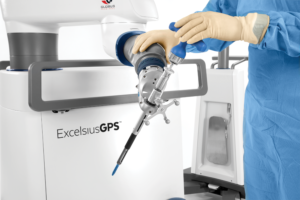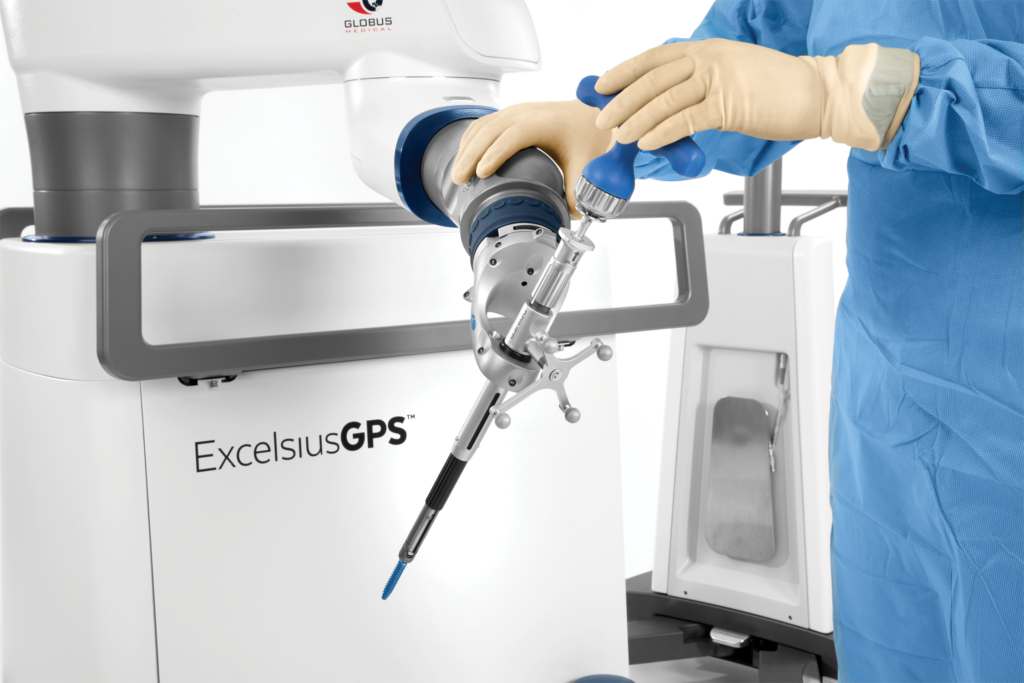Surgical Robots in a Post-Pandemic Marketplace

- December 27, 2021
- Posted in Excelsius™ Technology

Healthcare institutions continue to calculate the profound impact of the COVID-19 global pandemic.
In a February 2021 American Hospital Association (AHA) report,1 research showed that 2021 hospital revenue estimated a $53 to 122 billion loss due to the lingering effects of COVID-19. This is already riding off the projected loss of $323.1 billion in 2020.2
As a result of the pandemic, capital equipment needs to adapt to offer the latest and greatest technology while catering to considerably smaller capital expense budgets.
Rethinking Value and Investment
Single-purpose, one-trick-pony surgical robots can no longer survive in the post-pandemic market. Versatile technology is imperative. Just like a smartphone, users want to be able to “download” applications to fit their needs as opposed to buying a new phone every time they want to do something new.
Robotic systems that can accommodate a variety of surgical procedures, use a variety of tools, and complement surgical techniques will drive the new healthcare capital market.
Globus Medical addresses this problem with the ExcelsiusGPS™ revolutionary robotic navigation system. As a multifunctional system, ExcelsiusGPS™ offers a comprehensive approach for a wide range of spine and cranial applications.
“Spine surgery is inherently nuanced for each surgeon based on their training and preferences,” explains Mike Kaiser, a Globus Medical regional sales manager. “Robotic surgery with ExcelsiusGPS™ creates consistency in the accurate delivery of implant placement.”
This consistency is particularly evident in a clinical study by Dr. Arnold Vardiman, where the accuracy of pedicle screw placement was calculated between the attending surgeon and resident in navigated robotic-assisted minimally invasive spine surgery. The results demonstrated a high level of accuracy with no significant differences between pedicle screw placements placed by the attending surgeon and resident, 98.7% vs. 97.7%, respectively.3
Designed with innovation in mind, the ExcelsiusGPS™ robotic base station remains consistent while tools and applications are added to complement the newest evolution. This allows surgeons and OR staff from multiple departments to remain on the same system for a variety of procedures, from spinal fusions to brain biopsies, while hospitals only have to invest in one piece of capital equipment.
“The entire OR team becomes a closer-knit operation with ExcelsiusGPS™,” Mike Kaiser adds. “The uniformity and dependability give everyone piece of mind.”
Out of the COVID Curve
Post-pandemic recovery is ushering hospitals to act decisively on operational efficiency, especially in regard to robotic technology.4
When asked about how the growing robot market is impacting sales, Mike Kaiser said: “The growth of the robotic spine market is helping in two ways. First is that it is helping grow facilities that are early adopters in their market. The second point is that hospitals are quickly recognizing that ExcelsiusGPS™ is becoming a standard in their communities and that facilities utilizing robotic technology are moving ahead.”
And for surgeons who have adopted surgical robotic navigation in their OR, it is clear their perception of what is possible in surgery has expanded.
Nick Mason, a spine territory manager for Globus Medical, clarifies, “There’s a sense of urgency from surgeons when it comes to surgical robots. It’s an arms race to them, and surgeons need the best technology to create a win for both the patient and the hospital.”
Mike Kaiser similarly states, “The Spokane community has four ExcelsiusGPS™ robots within a relatively small marketplace and the only facility that doesn’t own one has already requested one as well. We see this quickly becoming a topic of conversation in the community with each new facility we engage.”
And now in a post-pandemic marketplace, it is clear the versatility and compatibility of ExcelsiusGPS™ easily fit into the tight budgets and high demands of surgeons and hospitals alike.
1 https://www.aha.org/system/files/media/file/2021/03/Kaufman-Hall-2021-Margins-Report-final.pdf
2 https://www.aha.org/system/files/media/file/2020/06/aha-covid19-financial-impact-report.pdf
3 Vardiman, A. B. et al. Does the accuracy of pedicle screw placement differ between the attending surgeon and resident in navigated robotic assisted minimally invasive spine surgery. White paper (GMOAA13). Globus Medical, Inc. (August 2019).
4 Moawad GN, Rahman S, Martino MA, Klebanoff JS. Robotic surgery during the COVID pandemic: why now and why for the future. J Robot Surg. 2020 Dec;14(6):917-920. doi: 10.1007/s11701-020-01120-4. Epub 2020 Jul 20. PMID: 32691351; PMCID: PMC7370632.
